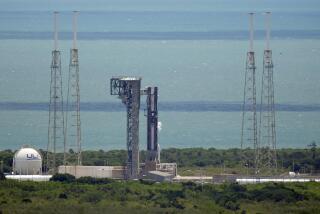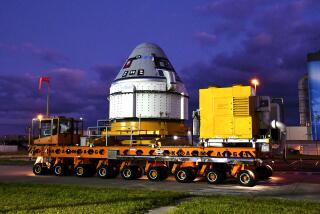Latest Shuttle Snag Puzzles Scientists; No Delay Expected
- Share via
KENNEDY SPACE CENTER, Fla. — NASA officials tried Monday to explain mysterious oxygen readings aboard the shuttle Discovery as the countdown clocks ticked toward the spaceship’s blastoff on a mission to upgrade the Hubble Space Telescope.
Officials said they were confident that higher-than-usual oxygen concentrations in Discovery’s fuselage would not delay the planned 12:55 a.m. PST launch today.
Meanwhile, astronaut Story Musgrave, a six-time space flier who helped mastermind the first Hubble repair, said he is leaving NASA after being told he would never fly in space again.
Officials of the National Aeronautics and Space Administration told Musgrave a year ago that a November 1996 space shuttle mission would be his last, and last week the 61-year-old astronaut was told the decision is final.
Tests on Discovery over the weekend appeared to rule out the possibility that the shuttle’s fuel cell system had sprung a tiny leak. The fuel cells beneath the shuttle’s cargo bay combine super-cold liquid oxygen and liquid hydrogen to generate electrical power and manufacture drinking water as a byproduct.
Engineers suspected the high oxygen could be linked to false readings from the shuttle’s gas detectors or that nitrogen gas used to ventilate the fuselage contained some air.
The launch team faced a second hurdle with the shuttle’s fuel cells Monday. Tests were underway to check that one of the three devices was working properly. There was a concern that it might produce drinking water that was too alkaline.
Two days after launch, the shuttle’s crew is scheduled to rendezvous with the orbiting Hubble Space Telescope and capture it. Four spacewalks are planned to install two new scientific instruments and to upgrade components.
For Musgrave, his departure from NASA later this year would end a three-decade career. Musgrave said although he would have jumped at the chance of flying in space again, he was not unhappy with the decision.
“I’m upbeat about it. I accept it. I’ve had one heck of a time of it. I’ve been able to do this for 30 years,” he said.
David Leestma, director of flight crew operations at NASA’s Johnson Space Center, said it was time for Musgrave to make way for younger astronauts who need to gain experience for work on the planned international space station.
Musgrave turned down the offer of a desk job helping to train new shuttle crews, saying he wanted to pursue new projects.
“They wanted me to stay and work, but I’m a flier,” he said. “I know my calling in space is not complete. It’s going to move into a different realm.”
More to Read
Sign up for Essential California
The most important California stories and recommendations in your inbox every morning.
You may occasionally receive promotional content from the Los Angeles Times.










